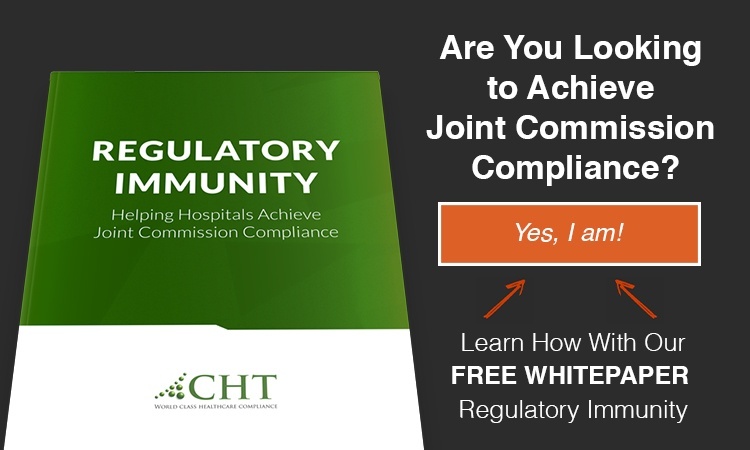
As operations managers and facility directors our work is judged not only by keeping the lights on and the fans running, but by the judgment of an accrediting agency making surprise or planned inspections on a regular basis.
These agencies sell their services to inspect, measure and record both equipment and processes. The end result is a report that may be available to the public on how well the hospital and the facilities department are doing their jobs.
Since this becomes the licensing function for the hospital and is made publicly available, most hospitals hire specially trained, certified firms to inspect them annually to make sure the thousands of regulations and guidelines are being carefully followed everyday not just when the inspector comes.
How Inspections and Accreditations Work According to TJC
(Paragraphs in quotes are taken directly from the Joint Commission).
“The Joint Commission has accredited hospitals for more than 60 years and today it accredits approximately 4,023 general, pediatric, long term acute, psychiatric, rehabilitation and specialty hospitals, and 366 critical access hospitals, through a separate accreditation program. Approximately 77 percent of the nation's hospitals are currently accredited by The Joint Commission, and approximately 88 percent of hospitals that are accredited in the United States are accredited by The Joint Commission.”
What's the Difference Between Hospital Accreditation and Certification?
“Accreditation can be earned by an entire health care organization, for example, hospitals, nursing homes, ambulatory care centers, office-based surgery practices, home care providers and laboratories.
Certification is earned by programs or services that may be based within or associated with a health care organization. For example, a Joint Commission-accredited medical center can have Joint Commission-certified programs or services for diabetes or heart disease care. These programs could be within the medical center or in the community.
Both accreditation and certification require an evaluation by The Joint Commission. The evaluation covers compliance with the standards and other requirements and verifies improvement activities. After earning accreditation or certification, health care organizations receive The Joint Commission’s Gold Seal of Approval®, a mark of quality.”
Cost of Hospital Accreditation
Usually hospitals are billed at the beginning of the year for the accreditation based on the number of patients and complexity of the services provided. Annual fees for hospitals are based on the type of hospital and weighted values for volume based on the types of service provided by a hospital.
The on-site survey fee is billed within seven days of the survey’s completion. Usually hospital management will be apprised of the result of the on-site survey or inspection before any results are published.
Facts About the On-Site Survey Process
“The Joint Commission survey process is data-driven, patient-centered and focused on evaluating actual care processes. The objectives of the survey are not only to evaluate the organization but also to provide education and “good practice” guidance that will help staff continually improve the organization’s performance.
Joint Commission on-site surveys are designed to be organization-specific, consistent and to support the organization’s efforts to improve performance. Survey length is determined by information supplied on the application.”
Unannounced Surveys
“An organization can have an unannounced survey between 18 and 36 months after its previous full survey (24 months for laboratories, which have their survey prior to when their accreditation expires). Most organizations receive no notice of the survey date prior to the start of the survey.”
On-Site Visit Focuses on Improvement
The on-site survey focuses on continuous operational improvement in support of safe, high-quality care, treatment and services.
The survey agenda usually includes a meeting with management to explain the inspection plan and answer any questions. The actual survey checks and documents operation and conditions for patients, staff and equipment.
What to Expect After the Survey
“Shortly after the survey, an organization’s report of survey findings is posted on the organization’s secure Joint Commission extranet. If an organization does not receive any requirements for improvement (RFIs), the accreditation decision becomes official at the same time that the organization’s summary report is available, and is effective the day after the completion of the survey.
If an organization receives RFIs, then the organization’s accreditation decision is made after the submission of an acceptable evidence of standards compliance (ESC) report.”
Quality Check - Online Guide to TJC
“When an organization’s accreditation decision becomes official, it is publicly disclosed. The decision will be posted to Quality Check® within one business day of being posted to the extranet.
Quality Check is the online guide to Joint Commission accredited and certified health care organizations in the United States.”
Conclusion
Hospitals with their own regular certified inspections find nearly all equipment deficiencies and correct them before the accreditation agency lists their “Requirements For Improvement” on their official inspection report.
Any RFI’s noted have to be repaired or corrected within 60 days of the deficiency being cited. It makes sense to keep all systems running effectively and avoid any questions from the agencies or the media.
photo credit: Shutterstock.com




